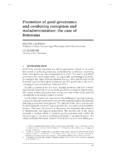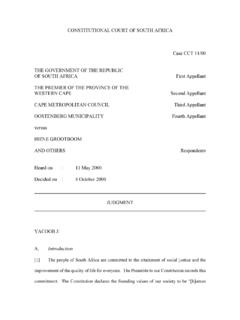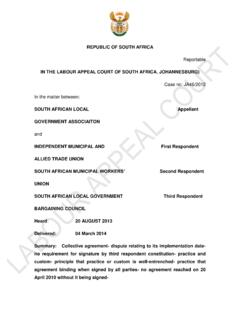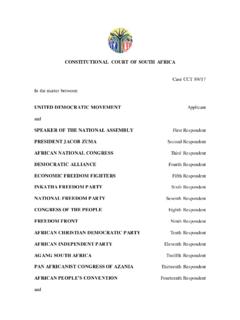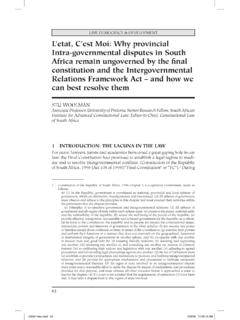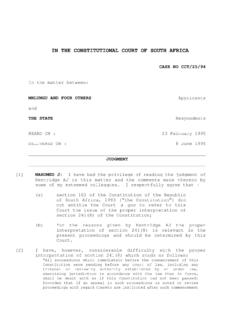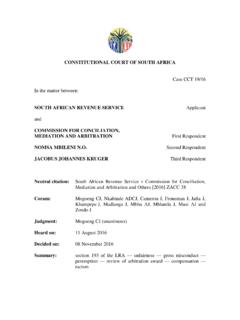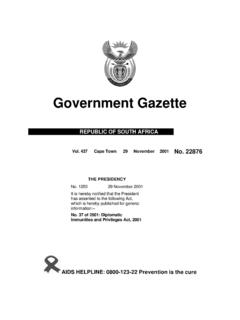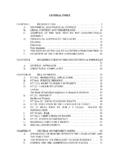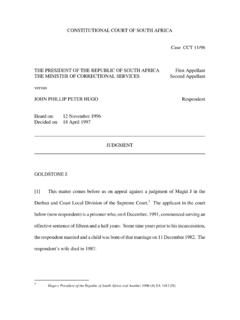Transcription of Public Participation: What has the Constitutional Court ...
1 102102102102 Public participation : what has the Constitutional Court given the Public ?Merafong Demarcation Forum and Others v President of Republic of South Africa and Others [2008] ZACC 10 LINDA NYATIB Com (Law) student, University of the Western Cape1 INTRODUCTIONThe Freedom Charter1 declared many years ago that (t)he People shall govern . When the Constitutional drafters devised a legislative system for our democracy they might have had this slogan in mind. South Africa s Constitutional democ-racy is representative and participatory in its nature. The representative aspect embraces multi-party democracy, achieved through regular elections based on a common voters roll and proportional representation;2 the participatory aspect goes further than regular elections every five years in that it guarantees involve-ment of each citizen in Public life in between elections.
2 These two aspects should not be seen as conflicting with each other but as complementary. To this extent Public participation is linked to the right to political participation . The right to political participation in terms of international law3 has expressly recog-nised the right to participate in Public life. In other words, Public participation in the legislative process is an integral part of any the Constitution of the Republic of South Africa4 ( the Constitution ) the right to vote5 at regular elections guarantees a democratically elected government 1 The Freedom Charter adopted at the Congress of the People, Kliptown Motala & Ramaphosa Constitutional Law: Analysis and cases (2002) South Africa adopted the International Covenant on Civil and Political Rights on 3 October 1994 and ratified it on 10 December 1998.
3 Article 25 reads as follows: Every citizen shall have the right and the opportunity , without any of the distinctions mentioned in article 2 and without unreasonable restrictions: (a) to take part in the conduct of Public affairs, directly or through freely chosen representatives; (b) to vote and to be elected at genuine periodic elections which shall be by universal and equal suffrage and shall be held by secret ballot, guaranteeing the free expression of the will of the electors. 4 Formerly known as Act 108 of S 19 (2) provides: Every citizen has the right to free, fair and regular elections for any legislative body established in terms of the participation that is accountable,6 responsive and open7.
4 The Constitution also specifies that the National Assembly, which is elected by the people, must ensure govern-ment by the people under the Constitution .. by providing a national forum for Public consideration of issues .8 It is sections 59(1)(a), 72(1)(a) and 118(1)(a)9 of the Constitution that establish Public participation in the legislative process. When the Public can participate in the legislative process, individually or as a collective, it signifies that everyone is regarded as significant and that their opinions are taken into consideration by the Constitutional Court ( the Court ) has on previous occasions been called upon to analyse and clarify the nature and extent of the obligation to facilitate Public involvement in legislation and other processes placed upon legislative bodies by the Constitution.
5 Most recently the Court addressed this issue in the case of Merafong Demarcation Forum and Others v President of Republic of South Africa and This article examines the extent to which Public participation in the legislative process is protected in the Constitution and more specifically, in light of the Merafong case, the justiciability of this right through the THE Constitutional DUTY TO FACILITATE Public INVOLVEMENTU nder previous regimes the majority of South Africans were excluded from Public life;12 in particular, they were denied the right to vote. In breaking from the old, sections 59(1)(a), 72(1)(a) and 118(1)(a)13 introduce a Constitutional duty on National Assembly, the National Council of Provinces and provincial legislatures respectively to facilitate Public participation when executing their legislative though legislative bodies have discretion in determining what pro cesses and procedures will be utilised to facilitate Public involvement, the Constitu-tional Court set out a test in Doctors for Life International v The Speaker of 6 S 41 (1) (c)
6 Provides All spheres of government and organs of the state within each sphere must provide effective, transparent, accountable and coherent government for the Republic as a One of the values in the founding provisions of the Constitution is stipulated in section 1 (d) as Universal suffrage, a national common voters roll, regular elections and multi-party system of democratic government, to ensure accountability, responsiveness and S42 (3):The National Assembly is elected to represent the people and to ensure government by the people under the Constitution. It does this by choosing the President, by providing a national forum for Public consideration of S 59(1)(a)The National Assembly must- (a) facilitate Public involvement in the legislative and other processes of the Assembly and its committees.
7 S 72(1)(a) The National Council of Provinces must- (a) facilitate Public involvement in the legisla-tive and other processes of the Council and its committees; .. S 118(1)(a) A provincial legislature must- (a) facilitate Public involvement in the legislative and other processes of the legislature and its committees; ..10 S v Makwanyane 1995 (6) BCLR 665 (CC), per O Regan J, para [2008] ZACC 1012 Brink v Kitshoff 1996 (6) BCLR 752 (CC) para See fn 9 above104 LAW, DEMOCRACY & DEVELOPMENTthe National The issues before the Court in the Doctors for Life International case were (i) what the nature of the duty to facilitate Public par-ticipation is; (ii) whether the legislature had discharged its duty to facilitate Public involvement in the legislative process of certain health related legislation; and (iii) what the impact on the validity of such legis lation if the facilitation of Public involvement was flawed is.
8 The test set is whether the legislature acted reasonably in discharging the duty to facilitate Public involvement. The follow-ing factors would also be taken into account in determining reasonableness: (i) the nature of the legislation concerned; (ii) the importance of the legislation; (iii) intensity of the impact on the public15, and other relevant factors which will depend on the circumstances of each case. Furthermore, at least two elements are encompassed by the duty to facilitate Public involvement; first, to provide meaningful opportunities for Public participation in the law-making process and secondly, to make sure that people have the ability to take advantage of the opportunities provided.
9 16 Sachs J, concurring with the majority judgment, emphasised the special meaning 17 of Public participation within our democ-racy and said the effect of Public participation should be that: All parties interested in legislation should feel that they have been given a real oppor-tunity to have their say, that they are taken seriously as citizens and that their views matter and will receive due consideration at the moments when they could possibly influ-ence decisions in a meaningful fashion. The objective is both symbolical and practical: the persons concerned must be manifestly shown the respect due to them as concerned citizens, and the legislators must have the benefit of all inputs that will enable them to produce the best possible laws.
10 18 This judgment clearly breaks away from the history that saw arbitrary legis-lative decision and the marginalisation of the majority of South Africans. This also creates an impression that the Constitutional Court is serious about addressing the injustices of the past and more importantly that the legislature should be accountable to the people who elected them. Doctors for Life set the standard of the Constitutional obligation to facilitate Public participation , but a fully fleshed out understanding was to be developed by later jurisprudence. Keeping in mind South African history, one would hope for Constitutional protection to be given against arbitrary enactment of Public participation IN CHANGING A PROVINCIAL BOUNDARYS outh Africa has a history of forced removals, issues pertaining to the pass laws and freedom of movement where Bantustan policies were used to entrench19, deepen and widen the divide between rich and poor, urban and rural, different races and between classes of With the realisation that the administration of cross-boundary municipalities was fraught with 14 2006 (12) BCLR 1399 (CC)15 Doctors for Life International (fn 14 above) para 128.
